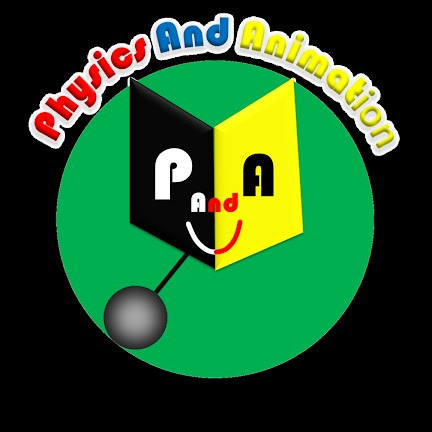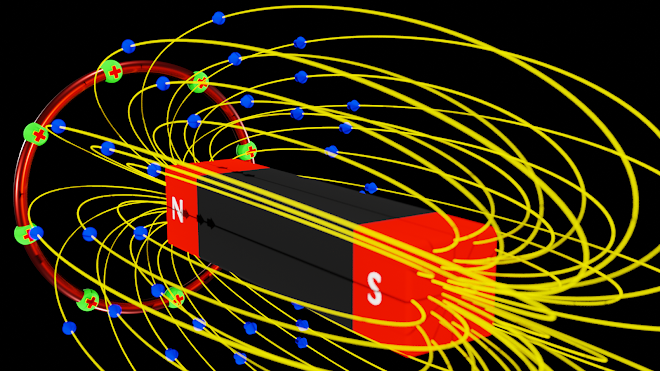Lenz's Law
Have you ever wondered how electricity can be produced from the movement of a magnet? Lenz's law holds the answer to this fascinating phenomenon. Hello friends, welcome back to Physics and Animation blog. In this post, we will talk about Lenz's Law and understand how it is based on the Law of Conservation of Energy. So, let's begin.
https://my.spline.design/untitled-768827a685648d73bd8299ed2401ded2/
Introduction:-
What is Lenz's Law? Lenz's Law is named after the physicist Heinrich Lenz and was formulated in 1834. Lenz's Law is based on Faraday's Law of Electromagnetic Induction, which states that changing magnetic flux will induce a current in a conductor. However, Lenz's Law tells us the direction of the induced current.
Let us perform an experiment to understand Lenz's Law. We have a single coil and a bar magnet which consists of magnetic field lines emerging from the North Pole and coming to the South Pole. Initially, there is no magnetic field in the coil. When the magnetic flux through the surface is changed by moving the North Pole of a bar magnet towards it, an induced EMF builds in it.
As there is a changing magnetic flux, which is changing the number of magnetic field lines passing through the cross-section of the coil, it causes the acceleration of charge carriers on the wire material, causing the current flow. This phenomenon is called Electromagnetic Induction, which we have already discussed in our post on Faraday's Law of Electromagnetic Induction.
Direction of Current -:
The question is, in which direction will the current flow? According to Lenz's Law, the current will flow in such a way so that it could oppose the cause which is inducing current in the coil. In this case, when we move the magnetic North Pole towards the coil, changing magnetic flux takes place due to the motion of the magnet. Hence, the current will flow in such a way so that it could create a magnetic field that is capable of opposing the change of magnetic flux taking place due to the motion of the magnet.
We all know that the side from which electric current appears to be flowing in an anticlockwise direction acts as a North Pole, while if electric current appears to be flowing in a clockwise direction, then that side acts as a South Pole. Also, we know that like poles repel each other, while unlike poles attract each other.
According to Lenz's Law, to oppose the changing magnetic flux, the current in the coil starts growing in an anticlockwise direction and acts like a North Pole to counter the cause, which is the moving magnet due to which magnetic flux is changing. Please note that the current flows in an anticlockwise direction only for the duration while the magnetic North Pole is heading towards the coil. It is obvious from Faraday's Law that as the magnet stops moving, the induction of electric current also stops because there is not any change in magnetic flux.
Please note that the coil will allow linking of magnetic field lines but not any increase or decrease in the number of magnetic field lines linking to the cross-section of the coil or any change in magnetic flux. If any change in magnetic flux occurs, the coil will oppose the change in magnetic flux by flowing charges in itself, resulting in the induction of electric current in the coil. In short, the only thing Lenz's Law does is to restrict the magnetic flux change.
Now let's move to the second case, in which we move the North Pole of a bar magnet away from the coil. When the magnetic North Pole is moving away from the coil, to oppose the changing magnetic flux, an electric current starts flowing in the coil such that it could attract the magnetic North Pole and oppose the motion of the magnet.
When a magnet moves away from a coil, it induces a change in magnetic flux in the coil. As a result, an EMF is generated in the coil, which creates an electric current that opposes the change in magnetic flux. According to Lenz's law, the direction of this induced current is such that it creates a magnetic field that opposes the original change in magnetic flux.
This opposing force is what causes the magnet to experience resistance as it moves away from the coil. To overcome this resistance, external work must be done, which in turn induces a greater EMF and current flow in the circuit.
Lenz's Law and Conservation of energy-:
It is important to note that Lenz's law is consistent with the law of conservation of energy. The energy expended to overcome the opposing force of the induced current is converted into electrical energy, which is then available to do useful work in the circuit.
In summary, Lenz's law is a fundamental principle that governs the behavior of electromagnetic systems. It ensures that energy is conserved and that the induced current flows in a direction that opposes the change in magnetic flux. By understanding this law, we can design and build more efficient and effective electrical systems.





